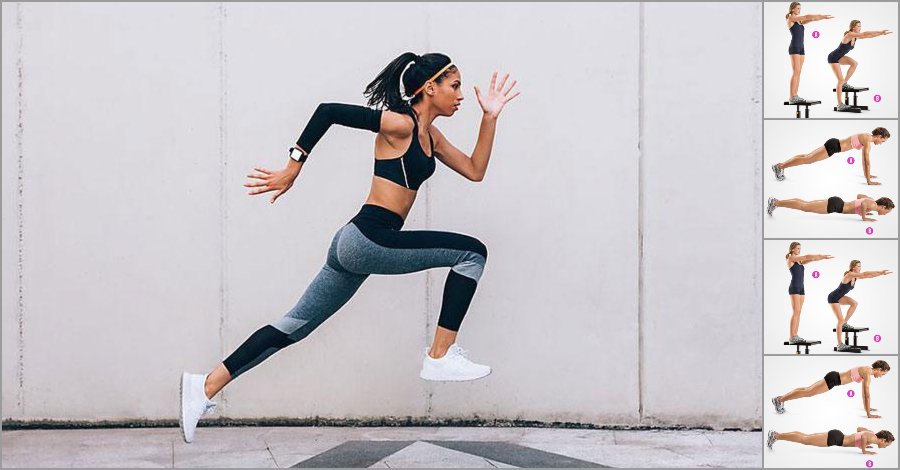Where is your body the strongest? The weakest? If you’re guessing right now, don’t go another week without doing these six exercises, which will give you objective answers to those two very important questions. (It’ll give you a total-body muscle-building workout, too. Bonus!)
Completing a full-body strength assessment like this is important because it shows you if you have a good and balanced foundation of strength throughout your body. If you do well at parts of it but not at others, then it pinpoints areas for improvement.
We’ve given you specific benchmarks for each exercise so that you know exactly where you’re coming up short. Sometimes we get so accustomed to the same workouts that we don’t realize we’re getting really strong in one area but neglecting another.
After your initial assessment, follow our instructions for how to modify the routine based on whether or not you’re hitting those benchmarks. For a balanced body head to toe, perform this workout two times per week until you’ve improved your weak areas.
Single-leg Squat:

How to:
- Stand with your left foot on a sturdy bench or box and your right foot hanging off the side (A).
- Bend your left knee and push your butt back to lower your right foot toward the floor (B).
- Press with your left leg to return to the starting position.
- That’s one rep.
- Do all of the reps on one leg, then switch.
Aim: 10 on each side
If you can do that: Do as many reps as possible on each side.
If you’re not there yet: You lack leg strength or hip stability. Put a hand on the wall for balance. Or hold onto a TRX (a yoga strap hung around a chin-up bar works, too) as you perform the move so that your arms support some of your weight.
Pushup:

How to:
- Get down on all fours with your hands slightly wider than shoulder-width (A).
- Keeping your body in a straight line from head to toe, bend your arms until your chest nearly touches the floor (B).
- Pause, then press your body back up to the starting position.
- That’s one rep.
Aim: 10 full pushups
If you can do that: Perform as many pushups as possible.
If you’re not there yet: You may lack strength in your arms or chest. You may also need to improve your core stability. Work up to full pushups by doing incline pushups with your hands on a low bench or box. Pause at the bottom of each rep.
Side Plank:

How to:
- Lie on your right side with your right forearm on the floor, your elbow underneath your shoulder.
- Stack your feet on top of one another.
- Raise your hips so that your body forms a straight line.
Aim: A 70-second hold on each side
If you can do that: Raise your top leg into the air for an extra challenge.
If you’re not there yet: The sides of your torso (your obliques) may be weak. Hold the exercise for as long as you can on each side.
Inverted Row:

How to:
- Set up a bar at the Smith machine (the squat rack that has an adjustable bar attached to it) so that it’s about three feet from the floor.
- Lie underneath the bar.
- Grab the bar with palms facing away from you, your hands just wider than your shoulders and your arms straight. (
- You should just be able to reach the bar; lower it if you can’t reach, or raise it if your elbows are bent.) (A).
- Pull your shoulder blades toward each other and bend your elbows to lift your chest to the bar.
- Keep your body in a straight line from chest to toes (B).
- Slowly lower your body until your arms are straight.
Aim: Eight reps, chest to bar
If you can do that: Prop your feet up on a box or bench, which will make the exercise harder.
If you’re not there yet: Most likely, your back muscles are weak. Do a few reps, rest for about 10 seconds, and repeat until you’ve completed all eight reps. If that’s too difficult, bend your knees so your feet are closer to the bar; this will make the exercise easier.
Single-leg Hip Raise With Head On Swiss Ball:

How to:
- Rest your head and upper back on top of a Swiss ball.
- Place your left foot flat on the floor, your hips slightly bent.
- Raise your right foot straight out (A). Lift your hips so that your body forms a straight line from your chest to your right foot (B).
- Dip your hips a few inches to return to the starting position.
- That’s one rep.
Aim: 15 reps
If you can do that: Hold a 10-pound dumbbell on your chest as you perform the exercise.
If you’re not there yet: Your glutes (butt muscles) are either weak or not working properly. Do as many as you can, rest about 10 seconds, and repeat until you’ve finished all 15 reps. If that’s still too hard, do as many single-leg reps as you can, then place both feet on the floor to make the exercise easier.
Swiss Ball Plank:

How to:
- Place your elbows and forearms on a Swiss ball.
- With your legs straight, place your toes on the floor.
- Your body should form a straight line from your head to your feet.
- Brace your abs; hold this position.
Aim: A 60-second hold
If you can do that: Try the Swiss Ball Rollout. Do as many reps as you can in 60 seconds, performing each rep at a controlled, moderate pace.
If you’re not there yet: Your core muscles aren’t working effectively. They could be weak, or other muscles might be taking over for them. Hold the Swiss Ball Plank for as long as you can.

